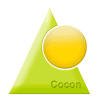In this screen those factors influencing the attenuation of a connection are being maintained.
What the (theoretical) attenuation will be for the two light frequencies used is indicated for each fiber, splice, and patch.
When it concerns a fiber type the attenuation will be stated per kilometer. When it concerns a splice the attenuation will be reported depending on the fiber types associated with the splice.
Usually, a cable is built up from extra lenghts, a piece of cable and extra lenghts. ( both extra lenghts may exist on frames, enclosures and slacks )
The cable lenght can ( if not entered in detail ) be determined on the basis of the geographical line in Cocon and added to both extra lenghts. This lenght is, of course, not the correct lenght. A cable never lies in a straight line in the ground and tube. For both deviations is an adjustable factor available in Cocon. ( extra fiber lenght by a stroke in a tube and extra fiber lenght by a ground stroke )
The cable lenght can also be entered in detail in the screen "change Span". As soon as the real lenghts are entered ( using lenght in / lenght out ) these values are considered true. No corrections will follow on the ground or tube stroke.
You can also choose to say that the cable has an external owner. In this situation no correction will follow on a ground or tube stroke.
Besides the cable lenght there's a fiber lenght and thus connections etc. This lenght is in principle never the same as the cable lenght. A fiber is twisted in the cable and therefore has more lenght. The extend of this depends on the set values per cable capacity-range. A.g. for all cables with a maximum of 36 fibers you can specify that they are 1% longer than the cable itself.
The "twist factor" can vary per tube. In the screem "manage cable types" you can determine per cable and, in it, per tube how big the twist needs to be per tube. It can happen that the cables are build up layered. A.g. the first 6 tubes are twisted in the center, the next 6 are twisted on the first and so on.. Every tube can have have a different twist factor. The more outside the bigger the value. A connection overview on fiber 1 will have, in this case, a smaller lenght than fiber 1 in tube 7. If you're not entering "0% twist" in the screen "manage cable type", the default value will be taken over for this cable capacity. If you enter 0%, there will be counted with 0%.
If an error is reported with Cocon, the user gives the distance he has from his equipment. This lenght must be entered in Cocon. Hereby, you need to settle the twist, depending on the set values. By reporting errors in external cables it takes into account the relationship between drawn lenght and specified lenght.
The Attenuation report screen displays the attenuation for each connection.
Chromatic dispersion can be registered per cable type.
What is chromatic dispersion?
A pulse occurs when a light source is turned on for a short time. This light exist of multiple wavelenghts ( colors ). A light pulse thus consists of a number of small pulses, each with its own wavelenght. Each wavelenght has his own speed in the glass fiber and arrives sooner or later on the destination. A sent lightpulse is therefore wider, the sides a re less steep. In the worst case one pulse runs into the other, so both pulses cannot be recognized. This is what we called, chromatic dispersion. This effect can be reduced by using a laser. ( almost mono chromatic with 1 wavelenght) This in contrast to a LED that has a much broader spectrum.
The following actions may be taken in this screen:
|
Add a fibertype. |
|
Remove the current fibertype. |
|
Edit the fibertype. |
|
Save the changes and close the screen. |
|
Cancel the changes and close the screen. |
Last edited: 04-10-2017

